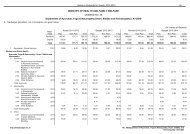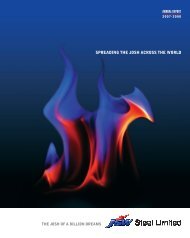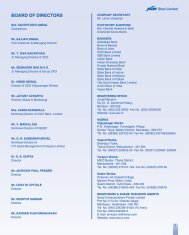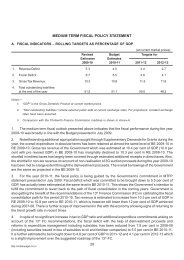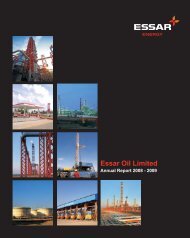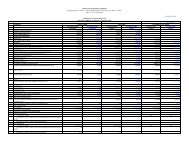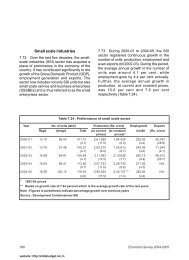in a Dynamic Environment - Domain-b
in a Dynamic Environment - Domain-b
in a Dynamic Environment - Domain-b
- No tags were found...
You also want an ePaper? Increase the reach of your titles
YUMPU automatically turns print PDFs into web optimized ePapers that Google loves.
services are rendered. Revenue from fixed price contracts is recognised as per the proportionate completionmethod with contract cost determ<strong>in</strong><strong>in</strong>g the degree of completion.Dividends are recorded when the right to receive payment is established. Interest <strong>in</strong>come is recognised on timeproportion basis.j) Research and DevelopmentResearch and Development expenditure is recognised <strong>in</strong> the profit and loss account when <strong>in</strong>curred. Fixed assetsutilised for research and development are capitalised and depreciated <strong>in</strong> accordance with the depreciation ratesset out <strong>in</strong> note 1(d).k) TaxationCurrent <strong>in</strong>come tax expense comprises taxes on <strong>in</strong>come from operations <strong>in</strong> India and <strong>in</strong> foreign jurisdictions.Income tax payable <strong>in</strong> India is determ<strong>in</strong>ed <strong>in</strong> accordance with the provisions of the Income Tax Act, 1961. Taxexpense relat<strong>in</strong>g to foreign operations is determ<strong>in</strong>ed <strong>in</strong> accordance with tax laws applicable <strong>in</strong> countries wheresuch operations are domiciled.M<strong>in</strong>imum alternative tax (MAT) paid <strong>in</strong> accordance to the tax laws, which gives rise to future economic benefits<strong>in</strong> the form of adjustment of future <strong>in</strong>come tax liability, is considered as an asset if there is conv<strong>in</strong>c<strong>in</strong>g evidencethat the Company will pay normal <strong>in</strong>come tax after the tax holiday period. Accord<strong>in</strong>gly, MAT is recognised asan asset <strong>in</strong> the balance sheet when it is probable that the future economic benefit associated with it will flow tothe Company and the asset can be measured reliably.Deferred tax expense or benefit is recognised on tim<strong>in</strong>g differences be<strong>in</strong>g the difference between taxable <strong>in</strong>comeand account<strong>in</strong>g <strong>in</strong>come that orig<strong>in</strong>ate <strong>in</strong> one period and are capable of reversal <strong>in</strong> one or more subsequentperiods. Deferred tax assets and liabilities are measured us<strong>in</strong>g the tax rates and tax laws that have been enactedor substantively enacted by the balance sheet date.In the event of unabsorbed depreciation and carry forward of losses, deferred tax assets are recognised only tothe extent that there is virtual certa<strong>in</strong>ty that sufficient future taxable <strong>in</strong>come will be available to realise suchassets. In other situations, deferred tax assets are recognised only to the extent that there is reasonable certa<strong>in</strong>tythat sufficient future taxable <strong>in</strong>come will be available to realise these assets.Advance taxes and provisions for current <strong>in</strong>come taxes are presented <strong>in</strong> the balance sheet after off-sett<strong>in</strong>gadvance taxes paid and <strong>in</strong>come tax provisions aris<strong>in</strong>g <strong>in</strong> the same tax jurisdiction and the Company <strong>in</strong>tends tosettle the asset and liability on a net basis.The Company offsets deferred tax assets and deferred tax liabilities if it has a legally enforceable right andthese relate to taxes on <strong>in</strong>come levied by the same govern<strong>in</strong>g taxation laws.l) Foreign currency transactionsIncome and expenses <strong>in</strong> foreign currencies are converted at exchange rates prevail<strong>in</strong>g on the date of thetransaction. Foreign currency monetary assets and liabilities other than net <strong>in</strong>vestments <strong>in</strong> non-<strong>in</strong>tegral foreignoperations are translated at the exchange rate prevail<strong>in</strong>g on the balance sheet date. Exchange difference aris<strong>in</strong>gon a monetary item that, <strong>in</strong> substance, forms part of an enterprise’s net <strong>in</strong>vestments <strong>in</strong> a non-<strong>in</strong>tegral foreignoperation are accumulated <strong>in</strong> a foreign currency translation reserve.Premium or discount on forward exchange contracts and currency option contracts are amortised and recognised<strong>in</strong> the profit and loss account over the period of the contract. Forward exchange contracts and currency optioncontracts outstand<strong>in</strong>g at the balance sheet date, other than designated cash flow hedges, are stated at fairvalues and any ga<strong>in</strong>s or losses are recognised <strong>in</strong> the profit and loss account.m) Derivative <strong>in</strong>struments and hedge account<strong>in</strong>gThe Company uses foreign currency forward contracts and currency options to hedge its risks associated withforeign currency fluctuations relat<strong>in</strong>g to certa<strong>in</strong> firm commitments and forecasted transactions. The Companydesignates these hedg<strong>in</strong>g <strong>in</strong>struments as cash flow hedges apply<strong>in</strong>g the recognition and measurement pr<strong>in</strong>ciplesset out <strong>in</strong> the Account<strong>in</strong>g Standard 30 “F<strong>in</strong>ancial Instruments: Recognition and Measurement” (AS–30).135




